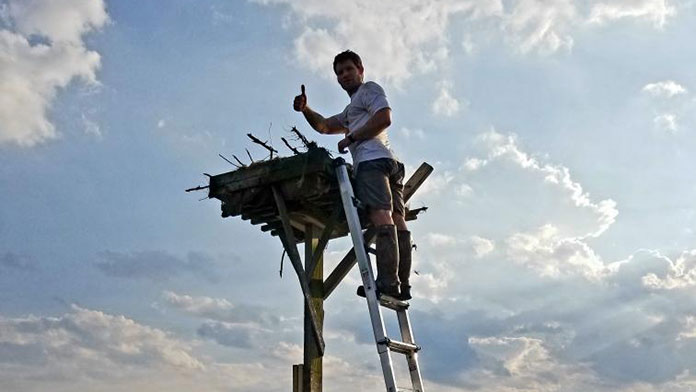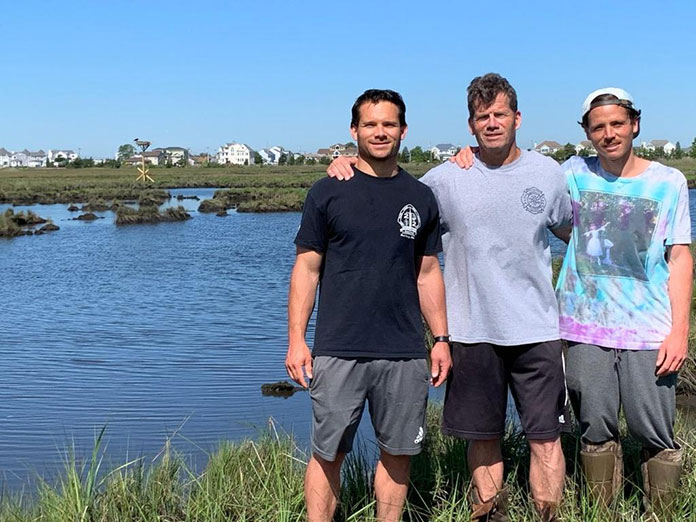
BRICK – An osprey family was reunited after a June 3 windstorm destroyed their nest by snapping its post at the base, throwing all three baby ospreys into the surrounding marshland. On that day, the National Weather Service reported winds of up to 82 mph in central NJ.
Brothers Danny and Matthew Dornacker, ages 34 and 29 respectively, grew up about 150 yards from the nest, which was built by their father some 25 years ago. Their parents, Dan Sr. and Cindy, still live in the Seawood Harbor house that has a 360 degree view of the marshland. All three men are Jersey City firefighters.
“My mom noticed that the nest blew over, and she called me in a panic,” said Danny from the raised porch of his parent’s home. “She said the stand was down and we had to fix it because there’s probably babies in the nest.”
Somewhere between one and three osprey chicks are raised in the nest each year, and Danny said his family takes pride in how their nest has contributed to the overall local osprey population, which has made a remarkable recovery since 1973 when they were listed as endangered by the NJ Division of Fish Game and Wildlife.

Due to the effects of DDT and a loss of habitat when trees were cut down for development, their population dropped from some 500 nesting pairs to only 53 in the state.
DDT was banned in 1968, and the osprey population began to recover through the efforts of biologists who relocated the eggs and chicks and installed manmade nesting platforms.
Now the NJ coastal region has an estimated 700 nesting pairs, and their status has gone from endangered to threatened. Many of the osprey nests are located on Barnegat Bay, 75 percent of which are on man-made structures.
After hanging up with his mother, Danny called his brother Matthew, who both live in Lake Riviera, and they headed over to their parents’ house.
“Our mom had already gone to Lowe’s for lumber to save time,” Danny recalled. “Matthew and I walked out to the nest in boots to scout the damage and to see what we needed.”
What they found in the marshland was the nest had fallen over like a tree. The nesting platform had detached from the stand, and the men could hear the baby ospreys, who were semi-buried under the debris.
“We were afraid the babies would be dead,” Danny said.

Matthew said they uncovered the babies and set them down on a mound of the nesting debris, creating a temporary safe place for them until they were ready to reset the stand.
“They didn’t look that well,” Matthew said. “They looked sapped and stressed.”
Meanwhile, the parents of the nestlings were circling overhead. “The adult ospreys were distressed – they were calling out and acting erratic. You could tell they weren’t comfortable,” Matthew said.
The men backed off, hoping the osprey adults would come back. They did come back, and one of them fed fish to their grounded nestlings.
About 45 minutes later, the men returned with the building supplies. The adult ospreys were still on the ground, guarding their chicks. When the brothers approached, the parents gave them space.
Matthew said they noticed that the young chicks appeared to have rebounded after spending time with their parents and eating the fish.

Danny and Matthew re-erected and re-enforced the existing stand, put another post about four feet deep into the ground, and connected the splinted posts with lag screws. The brothers further reinforced the post with bracing.
“We were trying to be efficient, because the babies were in high stress and the parents were watching from the waterline,” Danny said.
Once the stand was rebuilt, the men tried to recreate the nest by putting down a layer of burlap and layering it with some of the old nesting material. Danny added some eel grass and framed the nest with sticks.
While Danny was up on the ladder, Matthew handed him the nesting material while keeping an eye on the babies on the ground.
“The adult ospreys were hovering above, and watched while we carried the babies up to the nest in a makeshift burlap sack that worked great,” Matthew said.
Once the babies were back in the nest, the men backed off. When they were about 50 yards away, the adult ospreys returned to the nest, one by one.
“It was so great, it was so satisfying,” Matthew said afterwards. “It felt like a blessing.”
Danny said the family has a connection to the ospreys and gets a lot of enjoyment from watching them.
“I’m glad we could help them in what was potentially a tragic situation,” he said.






